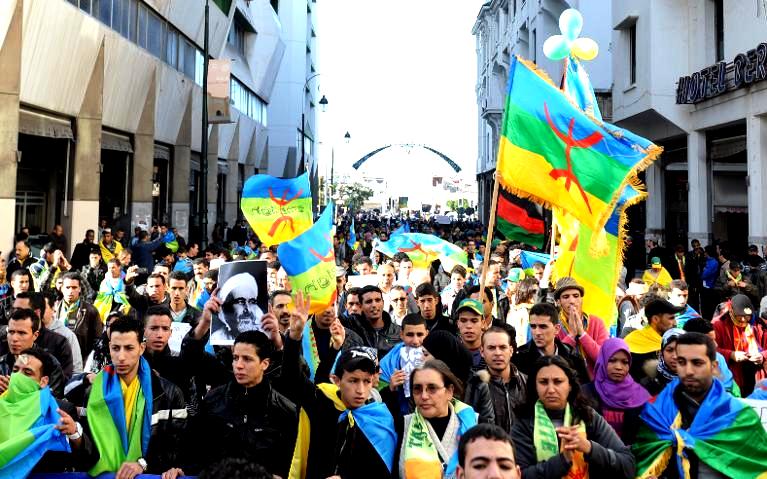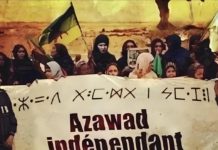By Peter Prengaman, June 26, 2015, A war of words over the Berber and Arabic languages is heating up in Morocco, threatening to divide the kingdom in much the same way the battle between French and English speakers divides Canada. Berbers were Morocco’s first inhabitants, and today they are still the majority, accounting for about 60 percent of Morocco’s 30 million citizens. But when it comes to speaking their views, they are treated like a minority by the members of the dominant Arab culture.
“More than 40 years after independence (from France), the government still doesn’t want to teach the Berber language and preserve or promote the culture, ” says Ahmed Lachgar Agwilal, a Moroccan-born San Franciscan who is a representative of the Amazigh (Berber) Commission for Development and Human Rights in America. “If you want to be Moroccan,” he says, “you have to speak this language.” The government disagrees. “Arabic is the official language of our identity, our Koran and our nation. The Moroccan citizen is duty-bound to speak his national language,” says Khalid Shebal of the government’s Institute for Arabization. At the police registries where Moroccans go to officially designate their childrens’ names, non-Arab names like Jurgurtha and Messina — the names of ancient Berber kings — are blacklisted. Only Arabic names like Hassan and Ahmed are allowed. “To Berber militants, this is a case of trying to completely eradicate any Berber heritage,” Jalali Saib, a leading activist who teaches at Rabat University, told the BBC earlier this year. The first language of most Moroccans is some form of Berber, generally called Tamazight, though there are a number of variants. But the constitution recognizes only Arabic as the official language. Arabic was imposed on the Berbers by the Muslims who conquered Morocco in waves of invasions beginning in the seventh century. Its influence waned a bit during the French colonial period, but after Morocco gained its independence in 1956, it surged again. In the 1970s, the government launched a campaign to impose stricter standards for the use of Arabic in place of French in government and education. Today, Berber activists say the “Arabization” of Morocco has led to discrimination and has marginalized their people. But the government has resisted calls for recognition of Tamazight as an official language of Morocco, fearing that the crusade will spawn a separatist movement. Morocco’s Berbers are “people in their own country who don’t exist,” complains Mahjoubi Aherdan, the charismatic leader of the National Popular Movement, a political party that represents rural Moroccans, many of whom are Berber. Even in schools in predominantly Berber areas, lessons are not taught in Tamazight but in Arabic. Government jobs are off-limits to those who speak only Berber, and Tamazight is prohibited in the courts; all legal documents must be translated into Arabic. Television programming follows suit. One government-affiliated channel, 2M, broadcasts a mix of Arabic and French. The other, RTM, broadcasts predominantly in Arabic, with only 5 to 10 minutes a day of news in Berber. Berber activists blame Arabization for the high illiteracy rate in Morocco – – 56 percent of its citizens cannot read — because Berber children often drop out when confronted with teachers who speak only Arabic. They also blame it for the continued poverty of most Berbers. Fifty percent of Moroccans live on less than $50 a month, and most of the poor are Berbers.
Language is all-important to Moroccan Berbers because it is the main attribute that unites their pluralistic culture. Though most Berbers are Muslim, some are Jewish and others are Christian. They are ethnically mixed and spread over the country, from the Rif mountain range in the north to the Atlas Mountains and the desert in the south. In Algeria, where Berbers make up 25 percent of the population, tensions have sometimes exploded into riots and bloody confrontations with police. The “Tamazight Spring” uprising of 1980 mobilized Berber anti-government sentiment, and hundreds were killed in the “Black October” riots of 1988. More recently, thousands of Berbers rioted in 1998 over a government decree making Arabic the official language of Algeria and the subsequent assassination of Matoub Lounes, a well-known musician and Berber activist, reputedly by the Armed Islamic Group, a fundamentalist insurgency. Moroccan Berbers have been less violent in their resistance to Arabization. But the controls on political expression have loosened since Mohammed VI ascended to the throne in 1999 after the death of his father, Hassan II, and Berber activist organizations have become better financed. As a result, Berber calls to re-examine Moroccan society have grown louder. Last March, Berber activists drafted and submitted to the government the “Berber Manifesto.” It called on the state to recognize Tamazight as a national language, teach Tamazight in schools, license a Berber television station, allot government money to speed up development in historically neglected areas, and end restrictions on registering Berber names for their children. Soon afterward, a government commission issued a much-publicized education charter calling for sweeping reforms of the Moroccan education system.
The charter was commissioned by the late King Hassan II, who raised Berbers’ hopes in 1994 when he said in a televised speech that Tamazight should be taught in schools, a pledge that was never fulfilled. Berber organizations denounced the education charter. They pointed out that only two of its 100 articles deal with the question of Tamazight in school. The first said Tamazight could be used in primary school only to “facilitate the learning of the official language” — Arabic. The second said that beginning this year, certain universities would have the means to study Tamazight and Berber culture. The charter’s provisions are “insufficient,” says Lachgar. “The government has to provide money for teaching Tamazight because it’s our language, it’s our culture.” Not all Berbers agree. While the majority are poor, there is an entire class of super-rich Berbers. Discriminated against in areas like education and government, they have flourished as businessmen and have bought up entire neighborhoods of Casablanca, such as the enclave known as California, where mansions resemble those in Beverly Hills. Some ardently support the Berber cause by funding activist groups, but others resist it. Says Ahmed Lousoure, a 34-year-old factory manager in Casablanca: “What good is Tamazight outside of Morocco? Our king is trying to modernize the country, not take a step back.” And there are divisions even among Berber activists. Some militants are pushing for a political party exclusively for Berbers, while moderates worry that it would be interpreted as separatist, allowing the Berber movement to be written off. Lachgar, who will travel in August to a U.N. conference on racism and indigenous peoples’ rights in Durban, South Africa, to make the case for official recognition of the Berber language, shrugs off the government’s suggestion that official recognition of Tamazight could lead to a separatist movement. “They just want to confuse people,” he says. “Nobody wants to separate because they consider all this land their land.
” Who Are the Berbers?
Long before San Francisco’s waterfront was known as the Barbary Coast, the North African coast was known as Barbary (from the Latin word for foreigners), and its inhabitants were the people now known as Berbers. Today, they number about 20 million and call themselves Imazaghen, which means “free and noble men.” Spread across Morocco, Algeria, Tunisia and, to a lesser extent, Libya and Egypt, they were conquered during the Arab invasion that started in the seventh century and, after fierce resistance over several centuries, were converted to Islam. Despite the conquest, Berbers retained their distinct culture, in which women have more freedom than among Arabs, and decisions are made communally. Two Berber tribes, the Almoravids and Almohads, built influential Islamic empires in northwestern Africa and Spain in the 11th to 13th centuries. The development of a written Berber language was suppressed by the waves of Arab invasions as Arabic was adopted for all official documents. In the 10th century, the Bourghwata kingdom translated the Koran into Berber, but the kingdom was vanquished by Sunni Muslim puritans, who burned the Berber Koran. Now, 11 centuries later, a Berber version of the Koran is about to be published. In later centuries, Berbers stubbornly resisted domination but were eventually pacified by the French, who ruled most of Morocco from 1912 to 1956. In the post-colonial period, Berbers have been politically divided. Some fought the king, including the plotters of several coup attempts on Hassan II in the 1970s, but others, including much of the officers’ corps, have been loyal to the monarchy.
Source: sfgate


















